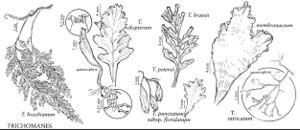Difference between revisions of "Trichomanes holopterum"
Farrnkräuter 1: 185. 1845.
FNA>Volume Importer |
imported>Volume Importer |
||
| (7 intermediate revisions by 2 users not shown) | |||
| Line 8: | Line 8: | ||
}} | }} | ||
|common_names=Entire-winged bristle fern | |common_names=Entire-winged bristle fern | ||
| + | |special_status={{Treatment/ID/Special_status | ||
| + | |code=F | ||
| + | |label=Illustrated | ||
| + | }} | ||
|basionyms= | |basionyms= | ||
|synonyms= | |synonyms= | ||
| Line 17: | Line 21: | ||
}}<!-- | }}<!-- | ||
| − | --><span class="statement" id="st- | + | --><span class="statement" id="st-undefined" data-properties=""><b>Plants </b>epiphytic. <b>Stems</b> erect, slender, bearing clustered leaves and numerous, slender, wiry roots, clothed at apices with dark, multicellular, gland-tipped hairs. <b>Leaves</b> lanceolate-oblong, pinnatifid, 2.5–10 × 0.5–2 cm, with sparse, 2-celled glandular hairs on veins; petioles shorter than blades. <b>Venation</b> pinnate, without unconnected false veins. <b>Soral</b> involucres terminal on vein ends at pinna apices, broadly conic and flaring at mouth. <b>Gametophytes</b> composed of proximal filamentous network supporting aerial blades tipped by gemmae. <b>Gemmae</b> regularly 4-celled with 2 green body cells and 2 nongreen rhizoid primordia. <b>2n</b> = 128.</span><!-- |
-->{{Treatment/Body | -->{{Treatment/Body | ||
| Line 23: | Line 27: | ||
|elevation=below 10 m | |elevation=below 10 m | ||
|distribution=Fla.;West Indies. | |distribution=Fla.;West Indies. | ||
| − | |discussion=<p>Although mature sporophytes of Trichomanes holopterum are very rare, gametophyte colonies are relatively common and more extensive and usually bear numerous young sporophytes, most of which seem unable to grow beyond a height of 1–2 cm. Persistence and vegetative reproduction by the gametophyte generation appear primarily responsible for maintenance of the species in the flora (C. E. Delchamps 1966; D. R. Farrar and W. H. Wagner Jr. 1968). The species probably also occurs elsewhere in cypress swamps along the Gulf Coast.</p> | + | |discussion=<p>Although mature sporophytes of <i>Trichomanes holopterum</i> are very rare, gametophyte colonies are relatively common and more extensive and usually bear numerous young sporophytes, most of which seem unable to grow beyond a height of 1–2 cm. Persistence and vegetative reproduction by the gametophyte generation appear primarily responsible for maintenance of the species in the flora (C. E. Delchamps 1966; D. R. Farrar and W. H. Wagner Jr. 1968). The species probably also occurs elsewhere in cypress swamps along the Gulf Coast.</p> |
|tables= | |tables= | ||
|references= | |references= | ||
| Line 32: | Line 36: | ||
-->{{#Taxon: | -->{{#Taxon: | ||
name=Trichomanes holopterum | name=Trichomanes holopterum | ||
| − | |||
|authority=Kunze | |authority=Kunze | ||
|rank=species | |rank=species | ||
| Line 45: | Line 48: | ||
|publication title=Farrnkräuter | |publication title=Farrnkräuter | ||
|publication year=1845 | |publication year=1845 | ||
| − | |special status= | + | |special status=Illustrated |
| − | |source xml=https:// | + | |source xml=https://bitbucket.org/aafc-mbb/fna-data-curation/src/2e0870ddd59836b60bcf96646a41e87ea5a5943a/coarse_grained_fna_xml/V2/V2_794.xml |
|genus=Trichomanes | |genus=Trichomanes | ||
|species=Trichomanes holopterum | |species=Trichomanes holopterum | ||
| − | |||
| − | |||
| − | |||
| − | |||
| − | |||
| − | |||
| − | |||
| − | |||
| − | |||
| − | |||
| − | |||
| − | |||
| − | |||
| − | |||
| − | |||
| − | |||
| − | |||
| − | |||
| − | |||
| − | |||
| − | |||
| − | |||
| − | |||
| − | |||
| − | |||
| − | |||
| − | |||
| − | |||
}}<!-- | }}<!-- | ||
-->[[Category:Treatment]][[Category:Trichomanes]] | -->[[Category:Treatment]][[Category:Trichomanes]] | ||
Latest revision as of 21:25, 5 November 2020
Plants epiphytic. Stems erect, slender, bearing clustered leaves and numerous, slender, wiry roots, clothed at apices with dark, multicellular, gland-tipped hairs. Leaves lanceolate-oblong, pinnatifid, 2.5–10 × 0.5–2 cm, with sparse, 2-celled glandular hairs on veins; petioles shorter than blades. Venation pinnate, without unconnected false veins. Soral involucres terminal on vein ends at pinna apices, broadly conic and flaring at mouth. Gametophytes composed of proximal filamentous network supporting aerial blades tipped by gemmae. Gemmae regularly 4-celled with 2 green body cells and 2 nongreen rhizoid primordia. 2n = 128.
Habitat: Epiphytic on decaying stumps and logs of bald cypress in dense cypress swamps
Elevation: below 10 m
Distribution

Fla., West Indies.
Discussion
Although mature sporophytes of Trichomanes holopterum are very rare, gametophyte colonies are relatively common and more extensive and usually bear numerous young sporophytes, most of which seem unable to grow beyond a height of 1–2 cm. Persistence and vegetative reproduction by the gametophyte generation appear primarily responsible for maintenance of the species in the flora (C. E. Delchamps 1966; D. R. Farrar and W. H. Wagner Jr. 1968). The species probably also occurs elsewhere in cypress swamps along the Gulf Coast.
Selected References
None.
